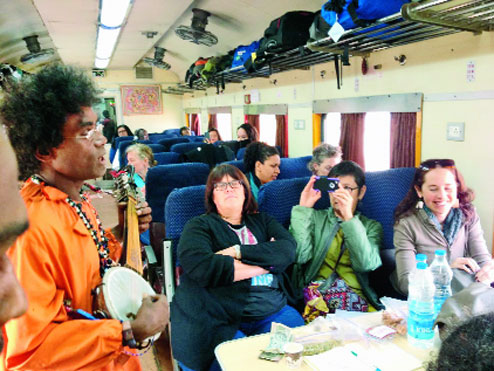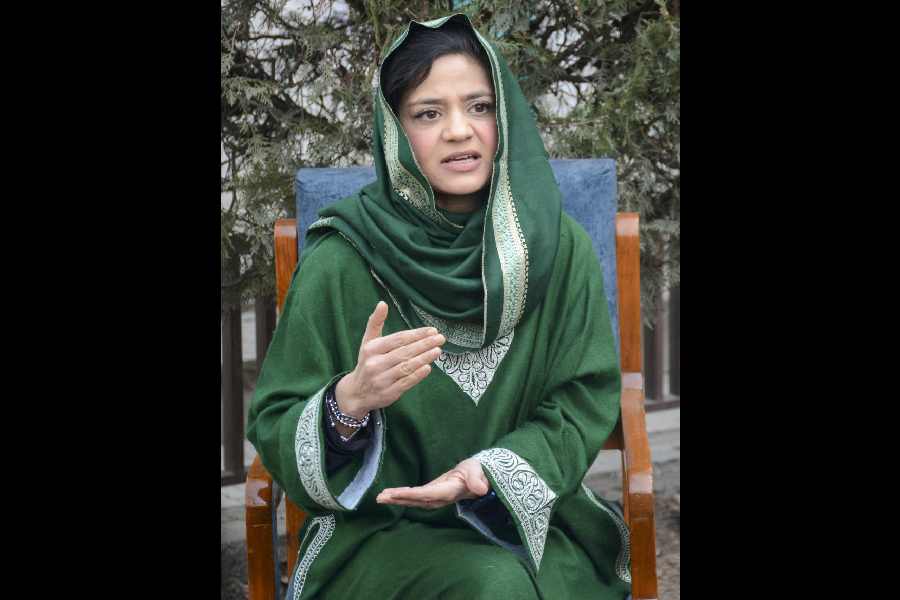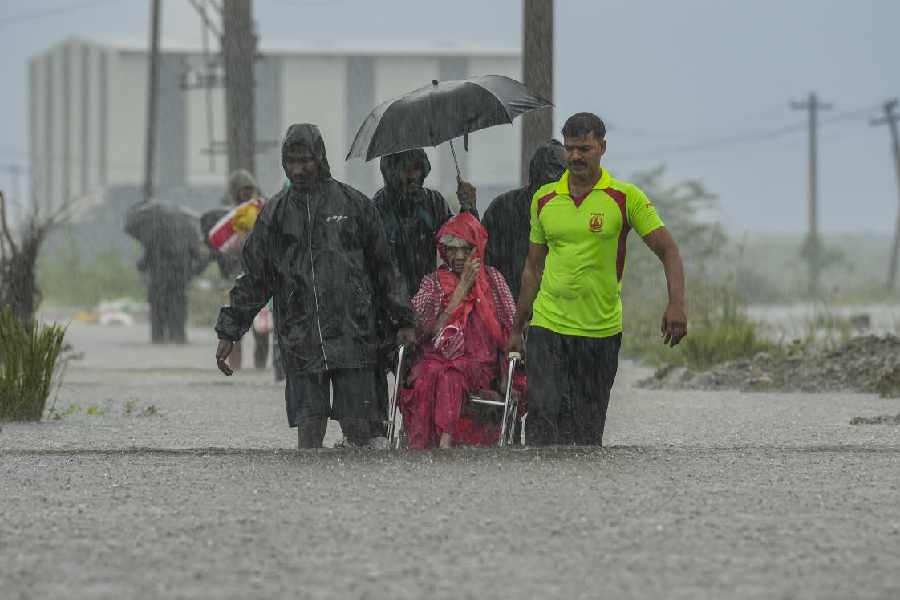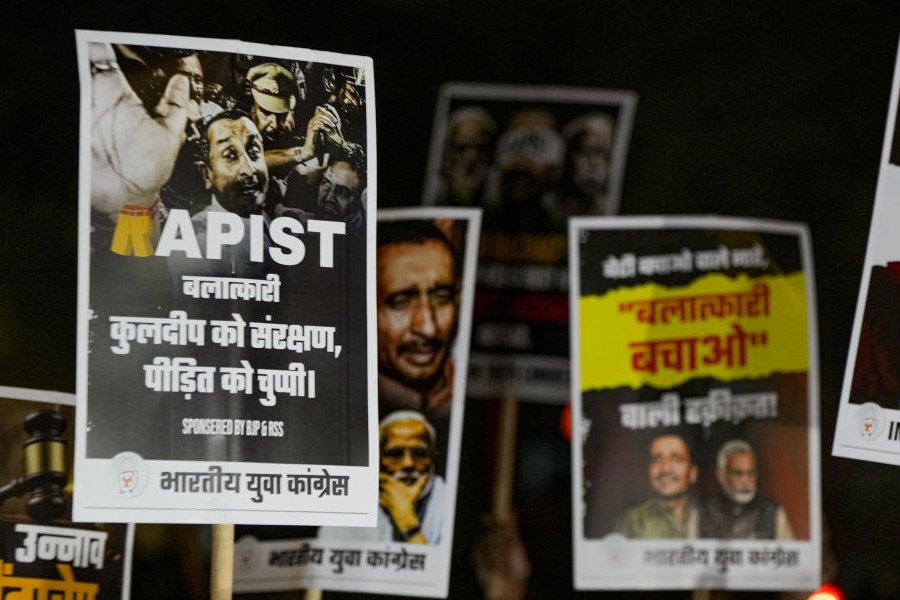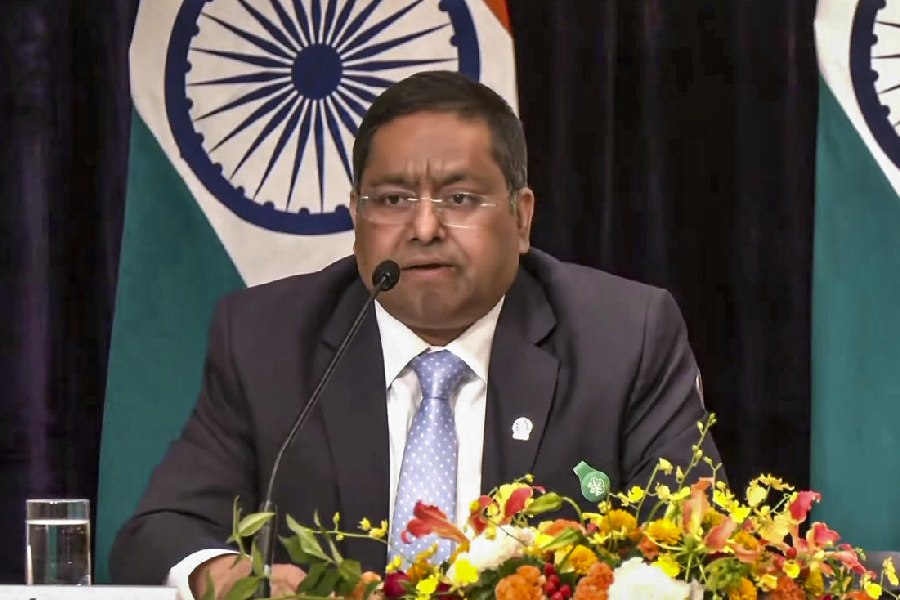 |
 |
 |
 |
 |
| Santiniketan lesson |
The American activists watch a Baul singer perform on the Santiniketan Express Visva-Bharati professor Amrit Sen shares Tagore’s ideas and philosophy with the group The team browses through the sculptures, frescoes and murals around Kala Bhavan Dinner and discussion with activists working for women’s rights in tribal areas Day II: Picking pottery at Lipi’s Studio, Boner Pukur Danga near Shantiniketan Day II: Picking pottery at Lipi’s Studio, Boner Pukur Danga near Shantiniketan Pictures by Mohua Das |
Baul songs and jhaal muri on a train to Santiniketan, lessons on female emancipation through tales of Chitrangada and Chandalika under Visva-Bharati trees, tryst with Tagore and tribal activism in modern India.
Metro trailed a team of 24 social activists from the US during their day-and-a-half visit to Santiniketan on Tuesday to learn how to build a movement from the grassroots as part of the NoVo Foundation’s Move to End Violence programme and “to realise realities far away from city life”.
DAY ONE
Tuesday, 10.10am: As the Santiniketan Express pulled out of Howrah station, all eyes were trained towards the window to savour the greenscape running miles into the horizon. “There was a reason why I was so interested in this train journey. While I wanted them to understand Gandhiji’s philosophy of travelling by train, I also wanted them to see the farmland. And to understand the huge onslaught on it right now that’s leading to displacement, debt, farmer suicides and trafficking,” said Ruchira Gupta, the founder-president of Apne Aap Women Worldwide that is supporting the Move to End Violence programme in India.
A while later, the irrepressible sound of Baul songs set to the rhythmic resonance of wheels on tracks stopped even those in a serious discussion on the trip to Tagore’s abode. Cristy Chung from San Francisco set her audio recorder on as the Bauls did a virtuoso song-and-dance performance in the compartment.
Monique Hoeflinger, a social justice consultant from New York, summed up the experience: “It felt like a beautiful flow between the complexity of the work we were doing, the environment on the moving train and the rhythm outside. To move in and out of that felt like a metaphor.”
4.30pm: The group assembles on the Visva-Bharati campus for their tryst with Tagore through a walk around Rabindra Bhavan and Kala Bhavan before settling down for a session under trees and in the midst of greens where Amrit Sen, a professor of English at the university, held fort. He shared with the group the ideas of Tagore and his philosophy with “treatment of women” as the focus area.
Kelly Miller from Idaho was “embarrassed” that she “hadn’t heard of him”. “I’m going to go home and read about him,” she promised.
Archi Pyati, an Indian-origin girl who grew up in Chicago, is well-versed in Tagore. “My grandfather had introduced me to Tagore. It’s educational, inspiring and very emotional to think about my grandfather and his wisdom as I walk through this place today,” said Archi, reading out a small excerpt of “Where the mind is without fear” for the group.
“There’s a call to action in this for something that Move to End Violence stands for, which is how we come together and build a movement to stop violence and not just react to it,” she said.
Sen told the group about the new and confident women in the Nobel Laureate’s dance dramas — Chandalika and Chitrangada — and his concern over bringing girls to the university “as performers to validate and sanctify women’s performance as a form in education and art”.
The professor fielded several enthusiastic queries and asked a few ones himself. He highlighted a wake-up call for the university when a Class V girl was forced last year to lick her urine for wetting her bed.
“I’d like to know from you how these problems should be dealt with? What are the things we could do so our university becomes far more sensitive?” he asked.
Ruchira pointed out the two realms: “Crime and punishment on one hand and counselling on the other.”
5.30pm: Browsing through the sculptures, frescoes and murals around Kala Bhavan, it was the idea of public art in a space meant for education that struck Jodeen Olguin Taylor, the field director at Caring Across Generations. “To make art accessible within nature and the campus as part of the philosophy of the education programme here and the environment that facilitates, I think is really powerful.”
7pm: It was an informal yet intense evening of interacting with a group of intellectuals and activists engaged with women’s rights and issues in the tribal areas. The dinner and discussion were at Mitali Homestays of Krishna Dey, an economist who used to work with the UN.
Dey happily played host as the group formed a ring to listen to the tribal activists while Ruchira donned the moderator’s cap.
Asha Mukherjee, who started the women’s studies department at Visva-Bharati, and Ayesha Khatoon and Maneesha, who work for empowerment of Muslim women in the backward areas, took turns to acquaint the guests with the purpose of their work.
Debbie Lee of Futures Without Violence was struck by “how people use religion to hold women in a much smaller space and keep them restricted”. Kelly was reminded of her hometown Idaho since “Santiniketan was very similar in terms of landscape”.
“So, the conversations about what women were doing to create opportunities to earn a living wage and how that was part of a solution to end violence against women was an important message that we try to implement in Idaho,” she said.
As the challenges ranged from social to political to religious, the common refrain was: “It’s a fight we all face and rang true for all of us.”
DAY TWO
n 11.30am: “This feels like a magical mystery chamber,” a voice rose from the murmured wows at Lipi’s Studio, a five-year-old quaint showroom at Boner Pukur Danga near Shantiniketan.
Lipi Biswas, working in Santiniketan as a potter for the past 14 years along with her husband and local artisans, runs the mud-and-brick studio. “We use naturally mined clay and ash glaze, which is made from garden rubbish,” she explained to her curious guests.
If the design, colours and finger-crafted forms prompted each one to grab several pieces of pottery unmindful of the precarious flight back home, it was also a way of doing their bit to “support the local community”.
What intrigued the group was perhaps a little story accompanying each clay and ceramic piece. “This bowl which is rough on the outside and glazed inside is like the insecurity within us. This bowl is not meant to break your heart but contain it and rejuvenate it,” explained Lipi as she held up a bowl that Scheherazade Tillet, an art therapist from Chicago, had picked.
“I don’t know whether I love it because it looks so beautiful or because the thought behind it is so profound,” the therapist said.
Take-back
“What’s been valuable is to see academics and activists working as one. The problems that women face… the battering and sexual assault seem very similar to what we have in the US, poverty is deep here and the challenges vaster. The strategies that activists are employing right now are different from the US,” Debbie said.
Another focus was how to mobilise men and change their minds. Tony Porter, the only man in the group of 24 and co-founder of Call to Men that engages men and boys to develop a voice in the movement against violence on women, said: “It’s no longer uncommon to have men working in organisations or run such programmes. We’re growing in numbers because women are trying to do this all by themselves. We’re looking to do some web noise and have online conferences with organisations here to get more men involved in this work, to challenge them and change them.”
Andrea Lee, working on women’s workers and immigrants rights, was impressed with the sheer number of laws that Apne Aap had persuaded the government to pass.
For Kelly, going to the grassroots has been a food for thought. “It makes me wonder how we can make have more programmes, like the ones we’ve seen in India that is empowering women to take control of their selves. I’m seeing the work in our country in a new way.”
On the train back to Calcutta, Monique said she couldn’t get enough of the sun. “I know I’m not going to get any when I’m back home,” she said, red from an hour in the afternoon sun.
Rachel was just happy to be away from city life. “Living in New York, I can never get far enough from the city,” she said.
Ruchira explained: “A visit to Bengal was important because it shows grassroots activities in small and beautiful ways which we don’t see happening anywhere else without being monetised. Santiniketan was a lesson in how small stands up to the big.”
MEV’s next POA: Kelly put it in perspective: “We plan to spend more time individually before we start thinking of how to build a movement and integrate our learning in India into our work…. There’s so much clarity now.”

